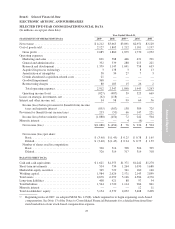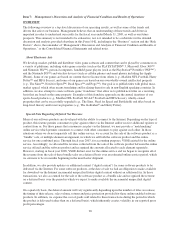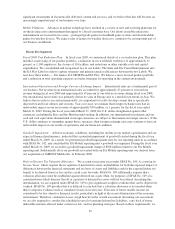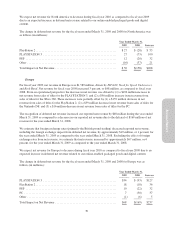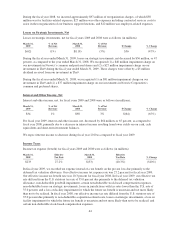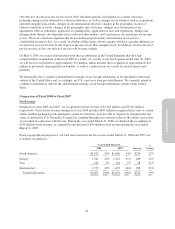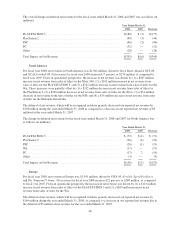Electronic Arts 2009 Annual Report Download - page 117
Download and view the complete annual report
Please find page 117 of the 2009 Electronic Arts annual report below. You can navigate through the pages in the report by either clicking on the pages listed below, or by using the keyword search tool below to find specific information within the annual report.
Annual Report
temporary differences representing approximately $46 million of deferred tax liabilities as a source of future
taxable income, and we would record a corresponding reduction in our valuation allowance.
Based on the assumptions and requirements noted above, we have recorded a valuation allowance against most of
our U.S. deferred tax assets, consisting of $232 million related to deferred tax assets that existed as of our fiscal
year ended March 31, 2008, plus an additional $134 million against deferred tax assets recorded during fiscal
year 2009. In addition, we expect to provide a valuation allowance on future U.S. tax benefits until we can
sustain a level of profitability or until other significant positive evidence arises that suggests that these benefits
are more likely than not to be realized.
In the ordinary course of our business, there are many transactions and calculations where the tax law and
ultimate tax determination is uncertain. As part of the process of preparing our Consolidated Financial
Statements, we are required to estimate our income taxes in each of the jurisdictions in which we operate prior to
the completion and filing of tax returns for such periods. This process requires estimating both our geographic
mix of income and our uncertain tax positions in each jurisdiction where we operate. These estimates involve
complex issues and require us to make judgments about the likely application of the tax law to our situation, as
well as with respect to other matters, such as anticipating the positions that we will take on tax returns prior to
our actually preparing the returns and the outcomes of disputes with tax authorities. The ultimate resolution of
these issues may take extended periods of time due to examinations by tax authorities and statutes of limitations.
In addition, changes in our business, including acquisitions, changes in our international corporate structure,
changes in the geographic location of business functions or assets, changes in the geographic mix and amount of
income, as well as changes in our agreements with tax authorities, valuation allowances, applicable accounting
rules, applicable tax laws and regulations, rulings and interpretations thereof, developments in tax audit and other
matters, and variations in the estimated and actual level of annual pre-tax income can affect the overall effective
income tax rate.
We historically have considered undistributed earnings of our foreign subsidiaries to be indefinitely reinvested
outside of the United States and, accordingly, no U.S. taxes have been provided thereon. We currently intend to
continue to indefinitely reinvest the undistributed earnings of our foreign subsidiaries outside of the United
States.
RESULTS OF OPERATIONS
Our fiscal year is reported on a 52 or 53-week period that ends on the Saturday nearest March 31. Our results of
operations for the fiscal years ended March 31, 2009, 2008 and 2007 contained 52 weeks and ended on
March 28, 2009, March 29, 2008 and March 31, 2007, respectively. For simplicity of disclosure, all fiscal periods
are referred to as ending on a calendar month end.
Comparison of Fiscal 2009 to Fiscal 2008
Net Revenue
Net revenue consists of sales generated from (1) video games sold as packaged goods and designed for play on
hardware consoles (such as the PLAYSTATION 3, Xbox 360 and Wii), PCs and handheld game players (such as
the Sony PSP and Nintendo DS), (2) video games for wireless devices (such as cellular phones and smart phones
including the Apple iPhone), (3) interactive online-enabled packaged goods, digital content, and online services
associated with these games, (4) services in connection with some of our online games, (5) programming third-
party web sites with our game content, (6) allowing other companies to manufacture and sell our products in
conjunction with other products, and (7) advertisements on our online web pages and in our games.
During fiscal years 2009 and 2008, we recognized total net revenue of $4,212 million and $3,665 million,
respectively. Our total net revenue during the fiscal years 2009 and 2008 includes $1,203 million and $831
million, respectively, recognized from sales of certain online-enabled packaged goods and digital content for
which we were not able to objectively determine the fair value (as defined by U.S. Generally Accepted
Accounting Principles for software sales) of the online service that we provided in connection with the sale
37


